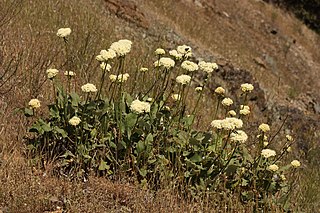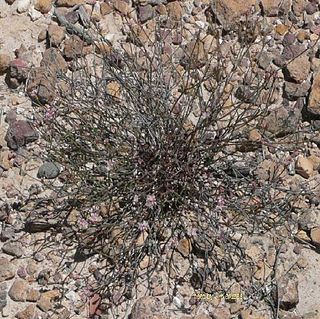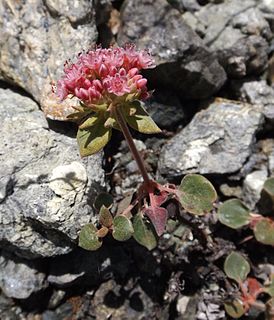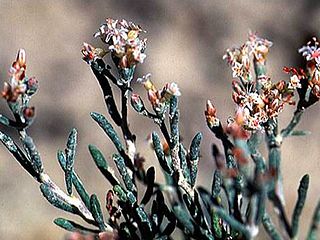
Eriogonum is a genus of flowering plants in the family Polygonaceae. The genus is found in North America and is known as wild buckwheat. This is a highly species-rich genus, and indications are that active speciation is continuing. It includes some common wildflowers such as the California buckwheat.

Eriogonum fasciculatum is a species of wild buckwheat known by the common names California buckwheat and eastern Mojave buckwheat.

Eriogonum longifolium var. harperi, also known as Harper's buckwheat or Harper's umbrella plant, is a dicot of the family Polygonaceae, found in areas of nutrient-poor shale soils in Alabama, Kentucky and Tennessee. It lives inconspicuously in an immature vegetative stage for four or more years before developing a flowering stalk, then flowers and dies. It is listed as an endangered species by the state of Tennessee. It has eleven small populations in Alabama and five in Tennessee but its survival in Kentucky is uncertain. According to a leading expert, Professor James L. Reveal of the University of Maryland, its Kentucky population has been reportedly extirpated. Its 2006 Alabama Natural Heritage Program ranking was G4T2S1, demonstrating an opinion that it was "critically imperiled" in that state.

Eriogonum alpinum is a species of wild buckwheat known by the common name Trinity buckwheat.

Eriogonum apricum is a rare species of wild buckwheat known by the common name Ione buckwheat. It is endemic to Amador County, California, in the United States.

Eriogonum arborescens is a species of wild buckwheat known by the common name Santa Cruz Island buckwheat.

Eriogonum nervulosum is a species of wild buckwheat known by the common name Snow Mountain buckwheat. This uncommon plant is endemic to the inland North Coast Ranges of California, where it is known from only a handful of occurrences, most of which are in Lake County. It is named for Snow Mountain, a local peak.

Eriogonum grande is a species of wild buckwheat known by the common name redflower buckwheat. It is native to northwestern Baja California, as well as the Channel Islands of California. It is a mat-forming perennial herb producing tall, stout inflorescences of white, pink, or red flowers. Leaves are located mainly at the base of the plant and are wavy along the edges and up to 10 centimeters long.
Eriogonum breedlovei is a rare species of wild buckwheat known by the common name Paiute buckwheat. It is endemic to the High Sierra Nevada of California, where its two varieties are uncommon members of the flora in granite and limestone rocky high mountain habitat.

Eriogonum eremicola is a rare species of wild buckwheat known by the common names Telescope Peak buckwheat and Wild Rose Canyon buckwheat. It is endemic to Inyo County, California, where it is known from only a few occurrences in the Inyo Mountains and Telescope Peak in Death Valley. It grows in sandy to rocky habitat in the forests and woodlands of these desert mountains. It is an annual herb producing a spreading, glandular, reddish green stem up to about 25 centimeters tall. The rounded, woolly leaves are up to about 2.5 centimeters long and are located at the base of the stem. The scattered inflorescences are small clusters of tiny flowers which are white with reddish stripes, aging to solid red, or sometimes yellow. The plant is under protection in Death Valley National Park.

Eriogonum gracile is a species of wild buckwheat known by the common name slender woolly buckwheat.

Eriogonum luteolum is a species of wild buckwheat known by the common name goldencarpet buckwheat. It is native to many of the mountain ranges of California and southern Oregon, including the Sierra Nevada, Cascades and California Coast Ranges. It grows in mountain and foothill habitat, such as forest and woodland, on granite and sometimes serpentine soils.
Malacothamnus abbottii is a rare species of flowering plant in the mallow family known by the common name Abbott's bushmallow. It is endemic to Monterey County, California, where it has recently been observed at only a few locations. It was historically known from a single specimen collection and the plant was presumed extinct until it was rediscovered in 1990 near San Ardo in the Salinas River drainage. It is now known from eleven occurrences, many of which are actually part of a single population, growing in vulnerable riverbeds near oil fields. Its habitat is periodically flooding riparian scrub among sandbar willows. This is a shrub with a slender, branching stem growing erect to a maximum height over one meter. It is coated in thin white hairs and bears toothed oval leaves a few centimeters long, sometimes divided into lobes. The inflorescence is a cluster of a few pale pink flowers with pointed oval petals 6 or 7 millimeters long.

Eriogonum callistum is a rare species of wild buckwheat, known by the common name Tehachapi buckwheat.
Eriogonum cedrorum is a rare species of wild buckwheat known by the common name The Cedars buckwheat. It is endemic to Sonoma County, California where it is known only from The Cedars, an unincorporated area outside of Guerneville near Cazadero.

Eriogonum spectabile is a rare species of wild buckwheat known by the common name Barron's buckwheat. It is endemic to Plumas County, California, where it is known from two occurrences in Lassen National Forest near Chester. There are approximately 250 individuals in existence. It grows in scrubby, forested mountain habitat, only on glaciated andesite substrates. This rare plant was discovered in 1997 and described to science as a new species in 2001.

Eriogonum pelinophilum is a rare species of wild buckwheat known by the common name clay-loving wild buckwheat. It is endemic to the state of Colorado in the United States, where it is known from only two counties. The most recent estimates available suggest there are 12 occurrences in existence for a total of about 278,000 individual plants in Delta and Montrose Counties. At least 7 occurrences observed in the past have not been relocated but are not yet believed extirpated. This plant is federally listed as an endangered species of the United States.

Eriogonum argophyllum is a species of wild buckwheat known by the common names Sulphur Hot Springs buckwheat, Silver Lake buckwheat, and Ruby Valley buckwheat. It is endemic to Nevada in the United States, where there is only one known population.
Eriogonum crosbyae is a species of wild buckwheat known by the common name Crosby's buckwheat. It is native to southcentral Oregon and northwestern Nevada in the United States. Some treatments include plants in Montana and Idaho as members of this species. This plant was first discovered in the Guano Valley in Lake County, Oregon, in 1978 by Bureau of Land Management botanist Virginia Crosby, and it was named for her in 1981.
Eriogonum diatomaceum is a species of wild buckwheat known by the common name Churchill Narrows buckwheat. It is endemic to Nevada in the United States, where it is known only from the Pine Nut Mountains in Lyon County. It is limited to the Churchill Narrows near Fort Churchill State Historic Park. This plant was discovered in 1997 and described to science in 2002.














